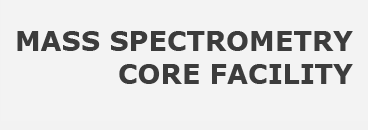
MS: A Fast Guide to Success
Sample Disposal and Submission Forms
Most important for having re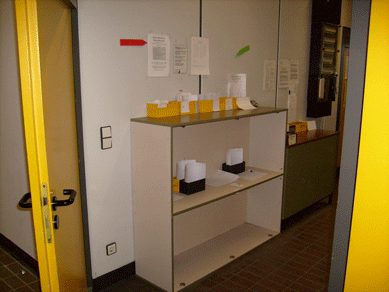 sults is that we get the samples.
sults is that we get the samples.
To submit the samples, you have to fill out the MS submission forms (provided in the sample disposal located in the entrance of rooms 13.12 and 13.13) or right here. In the moment the form is available in english, german, spanish and turkish.
The next thing is to place your samples fixed to the form in the right yellow box on top of the cupboard of the sample disposal. After some time, usually within three days, you'll find the measured samples as well as the print outs in the cupboard below the yellow boxes. By the way: important notes etc. are located at the wall in top of the yellow boxes (follow the red and green arrows).
Instrumentation
The samples which can be analyzed are limited by the available ionization methods and the mass limits of the analysators used.
At the MS Core Facility we have
- - EI-MS: modified MAT 711 (by an ancient company: Varian MAT)
- - ESI-IMS-MS/MS: UHPLC - Synapt G2-S HDMS (Waters)
- - ESI-FTICR-MS: Ionspec QFT-7 (Agilent/Varian)
- - GC/MS: Saturn 2100 GC/MS (Agilent/Varian)
- - HPLC/MS: Agilent LC/MS 6210 system (Agilent)
So, we lack ionization methods like (AP)PI (photo ionization), ICP (inductively coupled plasma) or MALDI, latter one of great importance not just for biological samples. NSI (nano-ESI) can be used on our FTICR-MS and the IM-MS/MS. The FTICR-MS also can be used with an APCI (Athmospheric Pressure Chemical Ionization) source.
The access to a MALDI-TOF/TOF (Dr. C. Weise) and an ICP-MS (T. Wons) at the biochemistry department can be discussed with the staff there.
EI-MS: modified 711 (room 13.10)
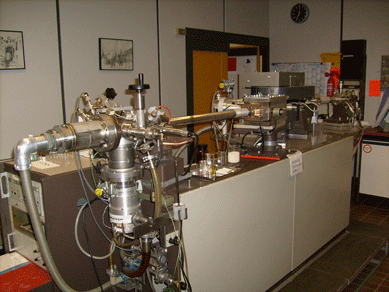
The MAT 711, built in the late seventies of the last century by Varian MAT, and installed 1977, thirty years later still is part of our fleet. Due to some major revisions and the caring maintenance by Dipl.-Ing. E. Seelbach, it provides an m/z range of 10 to ca. 6,000.
Since EI (electron impact) is used for ionization, the resulting mass spectra will consist usually of a lot of fragment ions (odd and even electron ions) as well as the M*+ radical ion. Low resolution measurements are provided. For having satisfying results and to prevent damage to the instrument, it is mandatory that the samples are pure liquids or solids. They have to be volatile, because the analytes have to be gaseous for ionization.
High resolution mass measurements are possible, but time consuming. A sufficient intensity of the respective ion is required. These measurements should be limited to important substances only.
Due to the age of the instrument measurements in negative ionization mode are not available. The usage of this instrument is strictly limited to MS Core Facility staff.
ESI - IMS-MS/MS, UPLC-Synapt G2-S HDMS (room 13.09)
With the ESI-IMS-MS/MS, an UPLC-Synapt G2-S HDMS by Waters, a new instrument has arrived at the mass spectrometry core facility. Currently it is installed and tested (January 2012). After some training it will be accessible for service measurements as well as for a limited number of working groups.
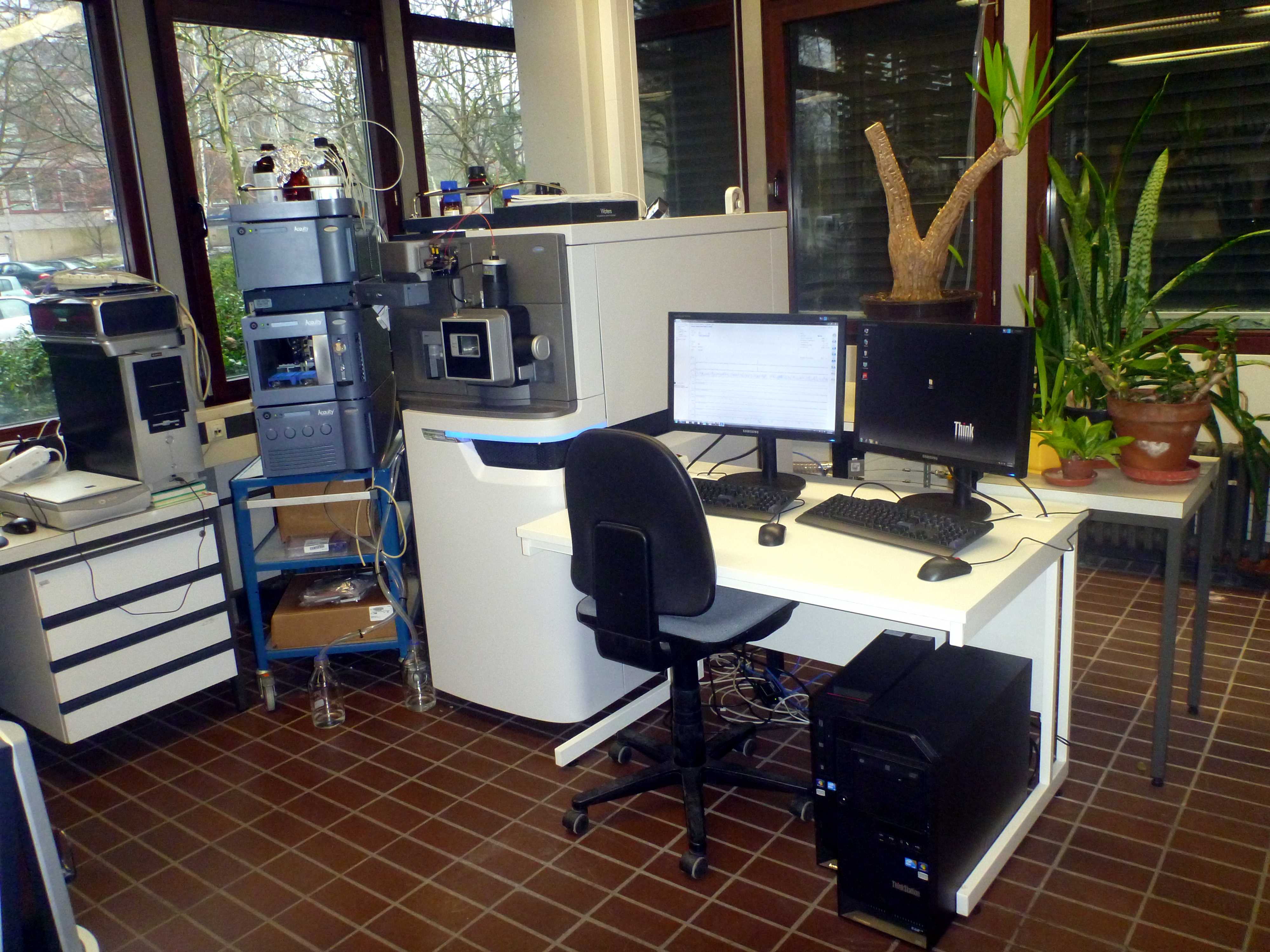
The system consists of two instruments coupled together:
1. An extremly powerful chromatographic system, an Acquity UPLC.
It consists of a binary pump system which allows generating pressures up to 1000 bar (15000 psi). With these pumps, chromatographic columns packed with extremely small particles (down to 1.7 µm) can be used. Very efficient and extremly fast separations can be performed.
Further it consists of an Autosampler which can be cooled down to 4°C, a column oven and a Photodiode array detector (PDA), which is capable to detect light in the visible and the UV range.
Since capillaries with an extremely small inner diameter and tiny particles as packing material are used, only specially filtered eluents and samples can be used to prevent clocking.
2. An ESI-IMS-MS/MS (Synapt G2-S HDMS).
The hybrid mass spectrometer principally consists of a Q-TOF instrument with the option to perform ion mobility measurements as well.
As options for ionization we currently have the choice to use a Z-Spray-ESI-ion source or a NSI-ion source. Both are equipped with a second sprayer (lock spray). This allows an additional external calibration while measuring. Thus, an extremely good mass accuracy can be achieved (about 1 ppm). The resolution of this Time-of-Flight (TOF) mass spectrometer is very high as well - more than 40.000 (FWHM) can be achieved. The extremely high mass range (m/z > 30.000) is very interesting, especially for very large, non-covalently bound complexes. A further benefit of this instrument is its ion mobility cell. The separation in this region of the instrument is not only induced by the m/z of the ions analyzed, but also by their shape. Thus, not only a very fast separation of very complex mixtures is possible, but also the separation of isobaric substances like e.g. peptides with reverse sequences. The IMS also is very important, since the collision cross sections of the ions can be derived from the drift times.
When ESI or NSI is used, the mass spectra will show cationized ions, [M+H]+ or [M+(Catn+)]n+, as well as multiply charged ions. Even for non-covalent complexes, fragment ions are rare. Since the instrument is very sensitive, chemical noise will add up to the background spectrum. The basic requirements which are pointed out in FTICR-MS and HPLC-MS are valid for this instrument as well.
FTICR MS: Ionspec QFT-7 (room 13.06)
Our ESI-FTICR MS, an Ionspec QFT-7 by Varian Inc. was installed in Oct. 2006. Equipped with either a Micromass/Waters Z-Spray electrospray ion source, a Micromass/Waters Z-Spray APCI source or a MS Horizons NSI Source it offers high resolution measurements and a stunning choice for ion manipulation as well as MSn.
Both, electrospray ionization (ESI) and nanospray ionization (NSI or nano-ESI), allow a very gentle ionization of polar of ionic analytes which are dissolved in mixtures methanol, 2-propanol or acetonitrile. Acetone and/or THF and up to 50% of water or 20% dichloromethane or chloroform are tolerable for ESI, while in NSI up to 95% water can be used. The analytes should be stable to oxygen and moisture. Easily oxidized analytes may undergo oxidation while the ionization process. For higher mass analytes in positive ion mode (a voltage of approx. 4 kV is applied at the spray capillary in case of ESI, and approx. 800 V in case of NSI) usually multiply charged, cationized ions of the kind [M+nH]n+ or [M+n(Cat1+)]n+ are detected. For APCI, the sample has to be volatile. Typically the [M+H]+ ions are generated. Samples should be as pure as possible, especially inorganic salts are surpreesing ionization.
The quadrupole section of the mass spectrometer provides mass selection and ion storage as well the possibility of collisional activation (CID) before the ions are transferred into the 7 Tesla superconducting magnet. The quadrupoles also are limiting the mass range to a maximum of about m/z 6,500, but even higher m/z ions may be detected in the ICR cell when highly charged parent ions are submitted to tandem MS.
The ICR cell (ion cyclotron resonance cell) provides a great choice of fragmentation methods like IRMPD, SORI-CID, ECD and the extremely time consuming BIRD. Additional leaking and pulsing valves facilitate gas phase reactions with gases and volatile liquids as well as stable-isotope exchange experiments, e.g., H/D exchange. Thus, this instrument provides us with many methods for structure elucidation, investigation of reaction mechanisms and thermodynamical properties of the analytes studied.
A limited number of specially trained users can use the instrument themselves. A PCs located in room 13.09 offers the chance of data evaluation.
GC/MS: Saturn 2100 GC/MS (room 13.03)
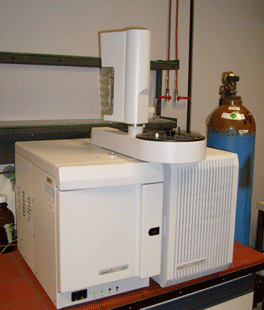 The GC/MS we use is a Saturn 2100 GC/MS system by Varian Inc.. It consists of a gas chromatography equipped with a column suitable for analyte solutions in nonpolar, volatile solvents like hexane. Solutions in water will destroy the injection system as well as the column.
The GC/MS we use is a Saturn 2100 GC/MS system by Varian Inc.. It consists of a gas chromatography equipped with a column suitable for analyte solutions in nonpolar, volatile solvents like hexane. Solutions in water will destroy the injection system as well as the column.
The samples have to be free of any salts and must contain highly volatile compounds only. As solvents for the samples, THF, diethyl ether, esters and hexane or propane are recommended. Aqueous solutions can not be analyzed like mentionend above.
Since the ionization taking place after chromatographic separation, all analytes are gaseous already. Electron impact (EI) is used. The resulting mass spectra thus will consist usually of a lot of fragment ions (odd and even electron ions) as well as M*+ radical ions for the lucky ones. Just low resolution measurements are possible, since an ion trap is used as analysator. Further limiting is the mass range of approx. m/z 20 to 650. This drawback is partly compensated by the possibility of automatic comparison of the generated spectra with a data base.
After some training the measurements are performed by the users themselves.
HPLC/MS: Agilent 6210 system (room 13.03)
There's also a HPLC/MS system in use. It is an Agilent 6210 system, consisting of an Agilent 1100 HPLC system with an additional DAD (diode array detector) and an ESI-MSD TOF by Agilent Technologies.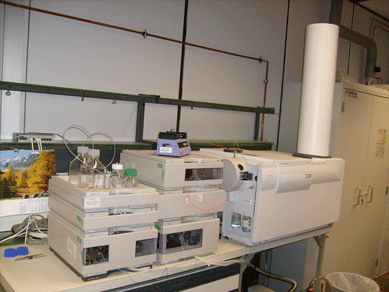
It provides high resolution spectra at very high mass precision (below 5 ppm with external and below 2 ppm with internal calibration, internal calibration is provided by a second in-built sprayer orthogonal to the spray capillary and the first sprayer). The mass range (m/z 50 to 3,500) means that nearly every ionic or polar compound can be detected, since ESI (electrospray ionization) is used to interface the LC system to the mass spectrometer. For higher mass analytes in positive ion mode (a voltage of approx. 4 kV is applied at the spray capillary) usually multiply charged, cationized ions of the kind [M+nH]n+ or [M+n(Cat1+)]n+ are detected. Samples should be as pure as possible. All other precautions are described in the FTICR section.
Direct infusion experiments can be performed by trained users, as long as they ensure that only filtered (4 µm filters), completely dissolved solutions are sprayed. Also, the sample concentration should be kept as low as possible to prevent carry-over and damage to the detector, a maximum concentration of 100 µmol/L is requested. Maximum number of counts per peak is 1,000,000 (106)! If you have higher counts, please dilute immediately! The saturation of the detector also leads to a dramatic loss in mass accuracy.
For LC/MS measurements, the measurements are perormed by the users themselves after some training. Additional to the precautions which should be taken into account for direct infusion measurements, the user has to ensure that all compounds in the sample solution are suitable for HPLC measurements. The samples must neither react with the column nor stick to the column for eternity. The pH of all samples and the solvents used should be between ph 7 and pH 4. As buffers, all highly volatile buffers (with anions like carbonate, acetate or formate and ammonium, triethylammonium etc. as cations) at a maximum concentration of 10 mmol/L can be used. No phosphate buffers can be used!
FAB-MS: CH-5 (now retired)
The FAB-MS, a CH-5 by Varian MAT, is now retired. It was working for the Freie Universität Berlin for more than thirty years.
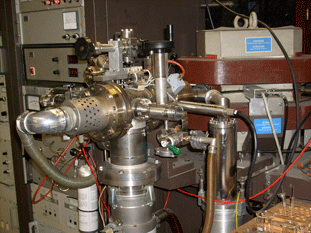 Die neueren Ionisierungsmethoden, ESI und MALDI, haben heutzutage FAB (Fast Atom Bombardment, Schneller Atom-Beschuss) fast vollständig verdrängt. Insbesondere bei einigen polaren oder ionischen Analyten, z.B. leicht oxidierbaren metallorganischen Verbindungen, war es von großem Nutzen. Die Präparation war, wie die Messung selbst, sehr zeitaufwendig. Die richtige Matrix musste gefunden werden, auch brauchte man für die Präparation eine vergleichsweise große Substanzmenge.
Die neueren Ionisierungsmethoden, ESI und MALDI, haben heutzutage FAB (Fast Atom Bombardment, Schneller Atom-Beschuss) fast vollständig verdrängt. Insbesondere bei einigen polaren oder ionischen Analyten, z.B. leicht oxidierbaren metallorganischen Verbindungen, war es von großem Nutzen. Die Präparation war, wie die Messung selbst, sehr zeitaufwendig. Die richtige Matrix musste gefunden werden, auch brauchte man für die Präparation eine vergleichsweise große Substanzmenge.
The new ionization methods, ESI and MALDI, nowadays nearly displaced FAB (fast atom bombardment), but for some uses it was good to have one of these machines, especially for some easily oxidizing metallo-organic compüounds and other small, polar or ionic compounds. Since the preparation was quite time-consuming, a matching matrix had to be found, and quite a lot of substance was necessary (but still not as much as for NMR!).
Mass spectra mainly consisted of the cationized ions, [M+H]+ or [M+(Cat1+)]+, but fragment ions were also common. Matrix cluster ions accompanied the analyte-derived peaks. In some cases they dominated the spectra.

